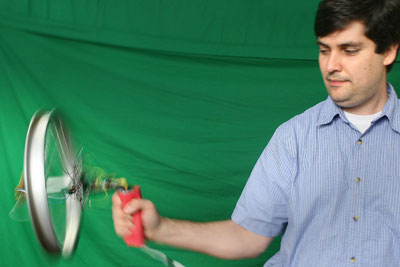Making music - as easy as spinning a gyrotyre
Making music - as easy as spinning a gyrotyre McGill University
User Tools (skip):
Making music — as easy as spining a gyrotyre

Marcelo Wanderley tests his grip strength while hitting the high notes on the gyrotyre.
Owen Egan
Jimi Hendrix gyrates his hips as he plays the guitar and the crowd goes wild. While these movements do not affect the music coming from the guitar, they add to the experience for the audience because both sounds and movements affect the audience.
At McGill, researchers study the significance of how performers move while they play a musical instrument. Using this information, Marcelo Wanderley, of the Schulich School of Music creates innovative digital musical instruments, such as the gyrotyre, that are designed to enhance the experience for both the audience and the performer.
Professor Wanderley analyzes the relationships between movements of performers and the sounds they produce. His team of graduate students uses 3D infra-red motion capture systems to identify patterns of musical notes and correlate these with the motions of the performer. Marcelo found that musicians always move their bodies in the same patterns when they play the same piece of music, even after a nine-month interval.
In another study, a collaboration with Bradley Vines and Daniel Levitin from the Department of Psychology at McGill, and Carol Krumhansl from Cornell University, they discovered that audiences subconsciously use a performer's movements to "listen" to the music. For this experiment, the audience watched a video without the music, and then listened to the music without the video. Participants were asked to identify the beginning and end of musical phrases. Surprisingly, the participants could more easily identify the beginnings of musical phrases from the mute video than from the music alone.
Wanderley is also interested in digital music because body movements are an important consideration for the design of digital musical instruments. Futuristic musical instruments litter his lab and computers buzz with activity from complex sensor and speaker arrays. A graduate student, Mark Marshall, stands in the middle of a room full of speakers and points at one. Music instantly emerges from it. "He is testing a magnetic sensor," Wanderley explained. "This sensor can be used on a digital instrument to adjust the sound, giving the impression that the music is being played in a bigger room or in a room made of rubber!"
Digital instruments designed in Wanderley's lab have cool names. The gyrotyre, a bicycle wheel instrument designed by graduate student Elliot Sinyor, uses a variety of sensors and can produce a spectrum of different rhythms, notes, and tones by moving and spinning it in different ways. Another example is the musical tube known as the Tiger Stick, which has sensors on every part of its structure and offers 56 "channels" for producing music. In fact, it is almost impossible to move or touch the Tiger Stick without making a sound. "Fortunately, a mute sensor is incorporated into the design, which is extremely useful when playing and composing," explained the designer Joe Malloch, another of Wanderley's graduate students. Such instruments and sensors are more than toys. They produce a greater range of musical sound than acoustic instruments and allow musicians to use a larger range of movements to express themselves.
Originally trained in electrical engineering in Brazil, Wanderley has an openness to new ideas and an enthusiasm for music that led him to the cutting edge of digital music design. "I appreciate many styles of music and my aim is to provide the tools that enable musical artists from all genres to express themselves in interesting new ways," he explained. Wanderley encourages students and professors to drop by his laboratory and experiment with his "designer" instruments.
More information: New Digital Musical Instruments, a book by Miranda and Marcelo Wanderley: www.areditions.com/cmdas/DAS21/cmdas021.html. The Input Devices and Music Interaction Laboratory website: www.music.mcgill.ca/musictech/idmil.

